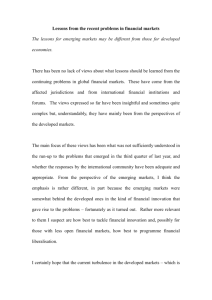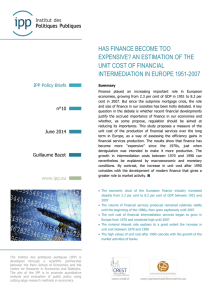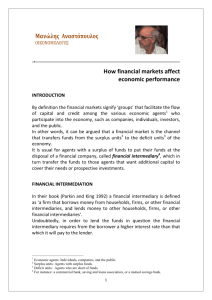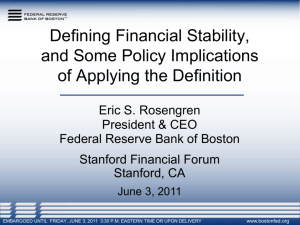Finance vs. Wal-Mart: Why are Financial
advertisement
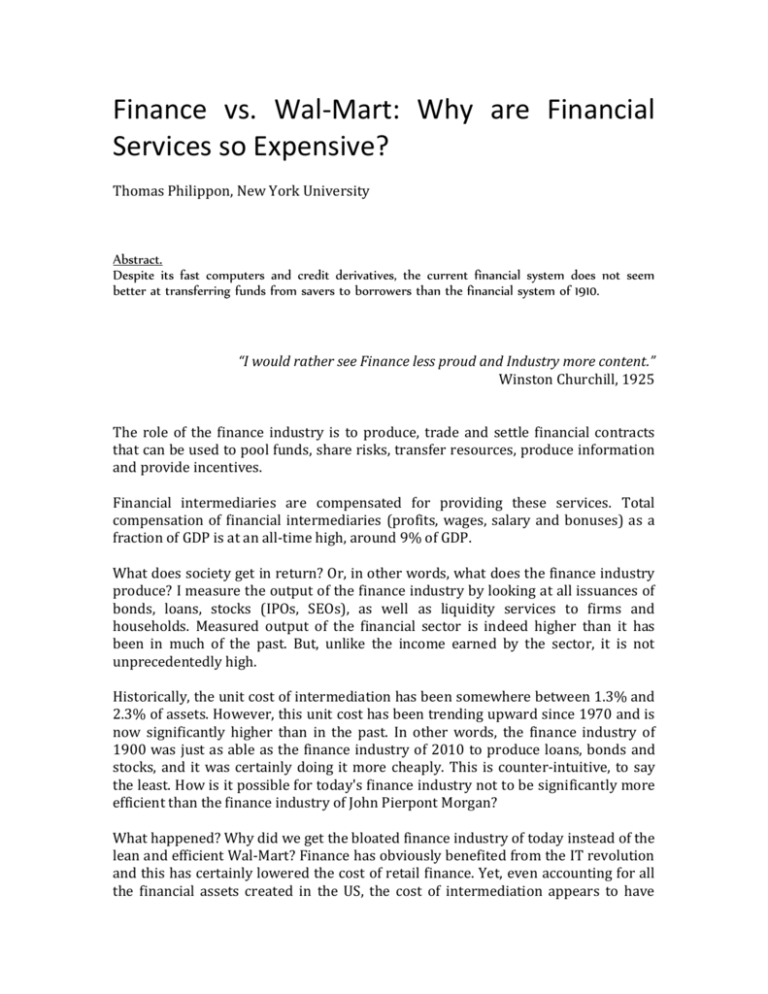
Finance vs. Wal-Mart: Why are Financial
Services so Expensive?
Thomas Philippon, New York University
Abstract.
Despite its fast computers and credit derivatives, the current financial system does not seem
better at transferring funds from savers to borrowers than the financial system of 1910.
“I would rather see Finance less proud and Industry more content.”
Winston Churchill, 1925
The role of the finance industry is to produce, trade and settle financial contracts
that can be used to pool funds, share risks, transfer resources, produce information
and provide incentives.
Financial intermediaries are compensated for providing these services. Total
compensation of financial intermediaries (profits, wages, salary and bonuses) as a
fraction of GDP is at an all-time high, around 9% of GDP.
What does society get in return? Or, in other words, what does the finance industry
produce? I measure the output of the finance industry by looking at all issuances of
bonds, loans, stocks (IPOs, SEOs), as well as liquidity services to firms and
households. Measured output of the financial sector is indeed higher than it has
been in much of the past. But, unlike the income earned by the sector, it is not
unprecedentedly high.
Historically, the unit cost of intermediation has been somewhere between 1.3% and
2.3% of assets. However, this unit cost has been trending upward since 1970 and is
now significantly higher than in the past. In other words, the finance industry of
1900 was just as able as the finance industry of 2010 to produce loans, bonds and
stocks, and it was certainly doing it more cheaply. This is counter-intuitive, to say
the least. How is it possible for today's finance industry not to be significantly more
efficient than the finance industry of John Pierpont Morgan?
What happened? Why did we get the bloated finance industry of today instead of the
lean and efficient Wal-Mart? Finance has obviously benefited from the IT revolution
and this has certainly lowered the cost of retail finance. Yet, even accounting for all
the financial assets created in the US, the cost of intermediation appears to have
increased. So why is the non-financial sector transferring so much income to the
financial sector?
One simple answer is that technological improvements in finance have mostly been
used to increase secondary market activities, i.e., trading. Trading activities are
many times larger than at any time in previous history. Trading costs have
decreased, but I find no evidence that increased liquidity has led to better (i.e., more
informative) prices or to more insurance.
Measuring the Cost of Financial Intermediation
The sum of all profits and wages paid to financial intermediaries represents the cost
of financial intermediation.
There are various ways to define the size of the financial sector. Conceptually, the
measure is:
Cost = Income of Finance Industry / Total Income
The three most important issues are:
1. Definition of “Finance.” For the most part, financial activities are classified
consistently over time (but sub-sectors within finance are not). The main
issue is with real estate. The value added of the “real estate” industry
includes rents and imputed rents for homeowners. Whenever possible, I
exclude real estate. In my notations, all variables indexed with “fin” include
finance and insurance and exclude real estate.
2. Definition of “Income.” The best conceptual measure is Value Added. In this
case, “Cost” is GDP of the finance industry over the GDP of the US economy.
However, this is only acceptable if we can exclude real estate, or at least
imputed rents. When this is not possible, a good alternative is to use the
compensation of employees. In this case, “Cost” is the compensation of
employees in finance over the total compensation of employees in the US. For
the post-war period, the two measures display the same trends, even though
annual changes can differ. This simply means that, in the long run, the labor
share of the finance industry is the same as the labor share of the rest of the
economy. In the short run, of course, profit rates can vary.
3. Definition of “Total Income.” During peacetime and without structural
change, it would make sense to simply use GDP. WWI and WWII take
resources away from the normal production of goods and services. Financial
intermediation should be compared to the non-war related GDP. To do so, I
construct a measure of GDP excluding defense spending. This adjustment
makes the series more stationary.
Figure 1: GDP Share of Finance Industry
I measure this cost from 1870 to 2010, as a share of GDP, and find large historical
variations, shown in Figure 1 (with the various data sources, see Philippon 2011 for
details).
The first important point to notice is that the measures are qualitatively and
quantitatively consistent. It is thus possible to create one “extended” series simply
by appending the older data to the newer ones.
The cost of intermediation grows from 2% to 6% from 1870 to 1930. It shrinks to
less than 4% in 1950, grows slowly to 5% in 1980, and then increases rapidly to
almost 9% in 2010.
This pattern is not driven by globalization or by structural changes in the economy.
The pattern remains the same if finance is measured as a share of services, and if net
financial exports are excluded (see Philippon, 2011).
The second key point is that finance was smaller in 1980 than in 1925. Given the
outstanding real growth over this period, it means that finance size is not simply
driven by economic development.
Measuring the Output of Financial Intermediation.
Next comes the issue of measuring the output of the financial sector. Following
Merton (1995) and Levine (2005), one can propose the following four categories of
financial services or functions:
Provide means of payment (ease the exchange of goods and services)
Produce information about investment opportunities
Monitor investments and exert corporate governance
Provide markets for insurance (diversification, risk management, liquidity)
These services are the output of the finance industry and its source of
economic value. To the extent that this higher total cost is met with
proportionally more output, the greater compensation of the sector should
not be surprising.
These services are provided to both households and firms, and facilitate the creation
of financial assets. The most important contracts involve the credit markets. I
measure the production of credit separately for households, farms, non-financial
corporate firms, financial firms, and the government.
I show in Philippon (2011) that a simple benchmark can be constructed using the
workhorse of modern macroeconomics, i.e., neo-classical growth model. This
benchmark is a weighted average of the financial assets created by the financial
sector for the real economy.
The most important trends in recent years are the increase in household debt, and
in financial firms’ debt. Figure 2 shows the outstanding bonds issued by Farms,
Households and Non Profit Organizations, and the Government. Household debt
exceeds 100% of GDP for the first time in history (see Figure 2), while financial debt
exceeds non-financial corporate debt for the first time. Surprisingly, the nonfinancial corporate credit market is smaller today than it was at its peak of the late
1920s.
Figure 2: Debt over GDP (selected sectors)
For the corporate sector, we need to look at bonds and stocks, and for stocks, we
want to distinguish seasoned offerings and IPOs. We also need to look at the
liquidity benefits of deposits and money market funds. When we put all the pieces
together, we obtain a series for output for the finance industry.
I then aggregate all types of non-financial credit, stock issuance, and liquidity
services from deposits and money market funds.
Figure 3: Financial Intermediation Output
I construct two series of output in Figure 3: One using the flows (gross issuances
over GDP) and one using the levels (debt over GDP). Note that both are relevant in
theory. Screening models apply to the flow of new issuances, while monitoring
models apply to the stocks. Trading applies to both.
The two series are displayed in Figure 3. The production of financial services
increases steadily until WWI, and rapidly after 1919 until 1929. It collapses during
the great depression and WWII. It increases steadily until 1975 and more randomly
afterwards. The flow and level measures share the same long term trends, but there
are clear differences at medium frequencies. The flow variable is more stationary
before WWI, suggesting a steady buildup of financial assets. The flow variable
collapses much faster during the great depression and the great recession. The level
variable peaks in 1933 because of deflation and the need to deal with rising default
rates.
The Decreasing Efficiency of Intermediation in the U.S.
I can then estimate the cost of financial intermediation, defined as the value added
share divided by output series. The cost of intermediation in the US (expressed as a
share of outstanding assets) is between 1.3% and 2.3%.
However, the cost of intermediation per dollar of assets created has increased over
the past 130 years, and especially since the 1970s. In other words, according to this
measure, the finance industry that sustained the expansion of railroads, steel and
chemical industries, and the electricity and automobile revolutions was more
efficient than the current finance industry.
Figure 4: Financial Intermediation Unit Cost
This is counter-intuitive. If anything, the technological development of the past 40
years (IT in particular) should have disproportionately increased efficiency in the
finance industry. How is it possible for today's finance industry not to be
significantly more efficient than the finance industry of John Pierpont Morgan?
It is important to understand that using the GDP share of finance to measure the
costs of financial intermediation captures all fees and spreads but it ignores hidden
costs of systemic risk. The neo-classical benchmark also assumes that all agents
borrow rationally ex-ante (of course, that does not rule out the fact that they might
end up with too much debt ex-post, but that means that they understand the risks
involved and choose to borrow). We can debate this assumption, but the point I
want to emphasize is that this provides an upper bound on financial efficiency. If
anything, adding excessive risk taking and over-borrowing would decrease the riskadjusted efficiency.1
For an insightful discussion, see Haldane and Madouros (2011), Popov and Smets (2011), and
Arcand, Berkes, and Panizza (2011).
1
Information Technologies: Where is Wal-Mart When We Need
It?
An obvious driving force in financial intermediation is information technology. I
often hear the argument that improvement in IT explains the increase in the share
of finance. This argument, however, is either incomplete or misleading. One reason
it is incomplete is simply that IT cannot explain the evolution of the GDP share of
finance before 1970.
What makes the IT argument misleading is that it is far from clear why IT should
increase the share of finance. The neo-classical growth model predicts that, in most
cases, technological improvement should lower the share of GDP spent on financial
intermediation. In particular, this prediction is unambiguous for most retail finance.
Essentially, the physical transaction costs of buying and holding financial assets
must have decreased because of IT. This effect must have lowered the amount spent
on intermediation.
An apt analogy is with retail and wholesale trade, since these are also
intermediation services.2 As Blanchard (2003) explains in his discussion of Basu et
al. (2003), “fully one-third of the increase in TFP growth from the first to the second
half of the 1990s in the United States came from the retail trade sector. For this
reason, the general merchandising segment, which represents 20% of sales in the
sector, was one of the sectors examined in a McKinsey study (McKinsey Global
Institute, 2001) aimed at understanding the factors behind U.S. TFP growth in the
1990s.”
Figure 5(a,b) shows the evolution of GDP shares and IT investment in wholesale
trade, retail trade.
For instance, one can compare retail finance and retail trade. Households go to grocery stores not
because they derive utility from doing so, but rather to have access to groceries. Similarly,
households use financial intermediaries to gain access to the financial products that they need.
2
Figure 5 IT Investment and GDP Shares of Retail and Wholesale Trade
Figure 6 shows this evolution for finance. The contrast is striking. Based on what we
see in wholesale and retail trade, IT should have made finance smaller, not larger.
Figure 6: IT and GDP Share in Finance
Trading
What happened? Why did we get the bloated finance industry of today instead of the
lean and efficient Wal-Mart? Finance has obviously benefited from the IT revolution
and this has certainly lowered the cost of retail finance. Yet, even accounting for all
the financial assets created in the US, the cost of intermediation appears to have
increased. So why is the non-financial sector transferring so much income to the
financial sector?
One simple answer is that technological improvements in finance have mostly been
used to increase secondary market activities, i.e., trading. Figure 7 shows trading in
the stock market. Foreign exchange trading volumes are more than 200 times larger
today than in 1977. Finally, trading accounts for a large fraction of revenues for the
largest banks.
Trading, of course, is neither a good nor a bad thing. It all depends on its impact on
the real economy. The output measures developed above, however, only capture the
production of financial assets (equity, bonds, money, etc.).3 Two important functions
of financial markets are not captured: the production of price information, and the
provision of insurance.
Figure 7: Equity Trading Volume over GDP
It is then important to ask the following question: If improvements in financial
intermediation lead to more informative prices or better risk sharing, where would
these improvements be seen in equilibrium?
Informativeness of Prices
In a model where managers learn from prices, better prices should lead to better
capital allocation and higher productivity.
Are prices more informative about future income streams? Preliminary evidence in
Bai, Philippon and Savov (2012) suggests no. They use a large panel of stock price
data and ask whether a stock’s price (relative to it’s assets) contains more
Note that the impact on average user costs is already taken into account. If trading lowers
borrowing costs, firms can borrow more and invest more. This would be captured by the previous
measures.
3
information about future earnings growth today than it has in the past. The answer
from this statistical analysis is no.
Risk Sharing
Another benefit of financial intermediation is risk sharing. Risk sharing can affect
firms and households.
At the firm level, risk sharing is commonly called risk management. Better risk
management would, in equilibrium, mostly translate into lower cost of fund, more
issuances and more investment. This first effect would be captured by our measures
of debt and equity issuances. Better risk management could also increase TFP if high
productivity projects are also riskier. I am not aware, however, of any evidence
suggesting improvement in risk management. The most obvious index, that of
precautionary savings by businesses, suggests even the opposite: corporate cash
holdings have increased over the past 30 years. There is also no direct evidence of
credit derivatives leading to better risk management, and it is commonly believed
that hedging represents a small fraction of all trades in the CDS market.
At the household level, better risk sharing should lead to less consumption risk.
Income inequality has increased dramatically in the US over the past 30 years. If
financial markets have improved risk sharing, however, one would expect
consumption inequality to have increased by less than income inequality. This is a
controversial issue, but Aguiar and Bils (2011) find that consumption inequality has
closely tracked income inequality over the period 1980-2007. It seems difficult to
argue that the vast sums of money spent on intermediation are justified by better
risk sharing among households. It is also unclear that any of the main financial
innovations of the past 20 years have improved risk sharing opportunities.
One area where there is evidence of improved consumption smoothing is in the
housing market. Gerardi et al. (2010) find that the purchase price of a household’s
home predicts its future income. The link is stronger after 1985, which coincides
with important innovations in the mortgage market. The increase in the relationship
is more pronounced for households more likely to be credit constrained. My model,
however, captures this type of smoothing and is reflected as increased mortgage
borrowing. Therefore, it does not bias my estimates.
Financial Derivatives
Derivatives markets have grown enormously. As of June 2011, the notional amount
of outstanding OTC contracts is $700 Trillions (BIS, December 2011), with interest
rates contracts (mostly swaps) accounting for $550T, and CDS for 32T. Measured at
gross market values the numbers are 20T, 13T, and 1.3T, respectively.
These numbers are certainly impressive, but the relevant question is: do they bear
any connection to measures of market and economic efficiency? The short answer
is: no.
Most people are struck when they hear the market for financial derivatives is 700
Trillion. These numbers are sometimes used to justify the costs of financial services.
This is misleading. Derivatives are just the plumbing of the financial markets. Endusers do not care about the plumbing, only about the quality of the service.
Another analogy comes to mind. Most people would probably be struck if they heard
that each Airbus A380 contains 40,300 connectors and 100,000 wires with a total
length of 330 miles (530km). The wires in a single airplane would be enough to go
from Philadelphia to Boston, or from Paris to London or Frankfurt. Should we
congratulate Airbus when it manages to increase the length of its wires? Or should
we only care about the safety, comfort, speed and fuel economy of the plane?
Similarly, suppose you were told that the “complexity and interconnectedness”
inside your computer had increased. Would you pay for the pleasure to have a
complex and interconnected computer, or would you only care about its speed,
design and battery life?
To understand better the relevance (or lack thereof) of financial derivatives,
consider the following example. Corporation A needs a long-term fixed-interest
loan. Making the loan would expose the lender(s) to duration risk and to credit risk.
How these risks are allocated, however, depends on the internal organization of the
finance industry. Consider two polar cases. Suppose first that the loan is made and
retained by bank B. Bank B must be compensated for bearing duration and credit
risks. For instance, B must monitor its credit exposure and maintain a buffer of
equity against credit risk. B must also monitor and hedge its interest rate risk. These
activities are costly and the costs are passed through to the borrowers through
spreads and fees.
Assume now that B can transfer credit risk to fund C using a CDS. Fund C now bears
the credit risk, while B retains the duration risk. B and C must be compensated
accordingly. The key point is that B and C together hold exactly the same risk as B in
the earlier example. Absent other frictions, the two examples are exactly equivalent
in terms of economic efficiency. Comparing the two polar cases, one can see that the
size of the CDS market bears no connection to any measure of efficiency.
Let us now extend the example. In terms of economic theory, derivatives can add
real value in one of two ways: (i) risk sharing; (ii) price discovery. Risk sharing
among intermediaries would not create a bias in my measurements, however. To
see why let us go back to the simple example. Suppose there are frictions that
rationalize why B and C should be separate entities, and why they gain from trading
with each other (i.e., B has a comparative advantage at managing duration risk, and
C at managing credit risk).
Then the existence of CDS contracts can improve risk sharing among
intermediaries, lower the risk premia, and lead to a decrease in the borrowing costs
of A. With free entry, the total income going to intermediaries {B+C} would
decrease. The unit cost measure developed earlier would correctly capture these
effects: either borrowing costs would go down, or borrowing volumes would go up,
or both. In all cases, my approach would register an increase in efficiency.
Therefore, the only bias from derivative contracts must come from better risk
sharing or price discovery among non-financial borrowers. The correct way to
measure the value added of derivatives is to directly measure the informativeness of
prices, or the welfare gains from risk sharing among non-financial firms and
households. As explained earlier, however, I am not aware of any evidence
suggesting better risk sharing or better prices.
Conclusion
The finance industry of 1900 was just as able as the finance industry of 2000 to
produce bonds and stocks, and it was certainly doing it more cheaply. But the recent
levels of trading activities are at least three times larger than at any time in previous
history. Trading costs have decreased (Hasbrouck (2009)), but the costs of active
fund management are large. French (2008) estimates that investors spend 0.67% of
asset value trying (in vain, by definition) to beat the market.
In the absence of evidence that increased trading led to either better prices or better
risk sharing, we would have to conclude that the finance industry's share of GDP is
about 2 percentage points higher than it needs to be and this would represent an
annual misallocation of resources of about $280 billions for the U.S. alone.
References
Aguiar, M., and M. Bils (2011): “Has Consumption Inequality Mirrored Income Inequality?”
Working Paper, University of Rochester.
Arcand, J.-L., E. Berkes, U. Panizza (2011), "Too much Finance?", VoxEU.org, 7 April.
Bai, J., T. Philippon, and A. Savov (2011): “Have Financial Prices Become More Informative?”
Basu, S., J. G. Fernald, N. Oulton, and S. Srinivasan (2003): “The Case of the Missing
Productivity Growth,” in NBER Macroeconomics Annual, ed. by M. Gertler, and K. Rogoff,
vol. 18, pp. 9–63.
Blanchard, O. (2003): “Comment on Basu et al.,” in NBER Macroeconomics Annual
Bolton, P., T. Santos, and J. Scheinkman (2011): “Cream Skimming in Financial Markets,”
Working Paper, Columbia University
French, K. R. (2008): “Presidential Address: The Cost of Active Investing,” The Journal of
Finance, 63(4), 1537–1573.
Gerardi, K. S., H. Rosen, and P. Willen (2010): “The Impact of Deregulation and Financial
Innovation on Consumers: The Case of the Mortgage Market,” Journal of Finance, 65(1),
333–360.
Haldane, A.G. and V. Madouros (2011), "What is the Contribution of the Financial Sector,
VoxEU.org, 22 November.
Hasbrouck, J. (2009): “Trading Costs and Returns for U.S. Equities: Estimating Effective
Costs from Daily Data,” Journal of Finance, 64(3), 1445–1477.
Levine, R. (2005): “Finance and Growth: Theory and Evidence,” in Handbook of Economic
Growth, ed. by P. Aghion, and S. Durlauf, vol. 1A, pp. 865–934. Elsevier, Amsterdam.
McKinsey Global Institute (2001), "US productivity growth 1995-2000. Understanding the
Contribution of Information Technology Relative to other Factors. Washington, D.C.
Merton, R. C. (1995): “A Functional Perspective of Financial Intermediation,” Financial
Management, 24, 23–41.
Philippon, T. (2011) “Has the U.S. Finance Industry Become Less Efficient?” mimeo NYU.
Popov, A. and F. Smets (2011), “On the tradeoff between growth and stability: The role of
financial markets”, VoxEU.org, 3 November.
